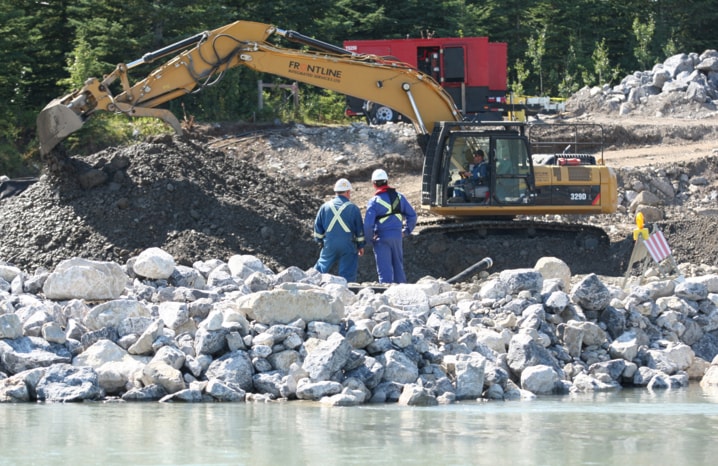Plains Midstream Canada has been blamed for numerous failures leading to a pipeline break under the Red Deer River near Sundre that released 462,000 litres of crude oil in June 2012.
“Our investigation has shown that it was very clearly the company’s failure to do what they were supposed to do under the regulatory system in Alberta,” said Darin Barter, a spokesman for the Alberta Energy Regulator (AER).
“Failure to do that caused, or certainly contributed to, oil getting into the Red Deer River — and that’s just not acceptable.”
The AER says the Calgary-based company did not inspect the pipeline annually or even follow its own pipeline integrity management program, says the report issued on Tuesday.
Plains Midstream also failed to undertake appropriate measures to combat erosion it had detected under the pipeline or “apply appropriate mitigation measures according to its own hazard assessment,” says the report on the June 7 spill that saw riverbanks coated in a layer of stinking black light sour crude. The leak forced the closure of Gleniffer Lake to recreational users and led to a fishing ban.
The company knew, following inspections in 2008, that the pipeline route under the river was prone to wash-out erosion yet “Plains did not apply any additional measures to reduce the likelihood or consequence of failure.”
The company also failed to limit the amount of crude oil that flowed out of the 12-inch (32-cm) pipeline by not responding properly to a provincial high stream flow advisory.
An investigation by pipeline experts determined that a “full guillotine failure” was detected at a pipeline weld at the west bank of the river.
The problem was pinpointed to “high-cycle fatigue, likely caused by vibrations induced by river flow, and that the section of the pipeline that failed must have been exposed during the incident and was likely uncovered by scour.”
Flow along that section of river is normally around 20 to 30 cubic metres per second. However, it hit 950 to 1,000 cubic metres per second on June 6 and was still running at 500 to 600 cubic metres per second on the day of the spill.
Had the company followed recommendations made during a 2011 inspection and isolated, purged and cleaned the river section of line during high-flow periods, “the release may have been prevented entirely or, if not prevented, the volume of fluid released from the pipeline would have been significantly reduced.”
Fortunately, the pipeline was offline and not pumping at the time of the incident. It has since been abandoned.
However, the cleanup took many months and cost in the tens of millions of dollars.
Four enforcement actions were issued against the company last July. They directed the company to update its emergency response plan and conduct an awareness program with residents in the emergency planning zone.
Pipelines crossing water or unstable ground must be annually inspected and engineering inspections undertaken when risk of pipeline failure has been identified.
The company must submit an action plan to the AER detailing what the company will do to prevent future regulatory non-compliance.
“Should the company fail to complete any of the of the required actions, the AER will issue additional high-risk enforcement action and escalate existing enforcement consequences,” says the report.
In a statement released on Tuesday, Plains says the company is reviewing the AER’s latest findings.
Since the incident, the company has worked to clean up the oil and mitigate its impact.
“Plains has taken significant steps since the incident to reduce the potential for further incidents to occur,” says the company. “This includes the completion of corrective measures to address the four high-risk enforcement actions issued by the AER and the development of an industry-leading watercourse management program.”
The AER isn’t done with Plains. The company’s Alberta operations are being audited, with a report expected to come out later this year.
“Ultimately, the outcome will determine whether the company can continue to operate in Alberta under the regulatory system,” said Barter.
“At this point, we’re not convinced that’s the case.”
In April 2011, a Plains-owned pipeline spilled 4.5 million litres of light crude near a First Nations community about 100 km northeast of Peace River. In June 2013, another 150,000 litres of oil condensate was spilled northwest of Manning.
Ila Johnston and husband Wayne live within sight of the Sundre-area spill and word of the company’s multiple failings comes as no surprise to her.
“Sounds typical,” she said on Tuesday.
Nearly two years later, the Johnstons still have not settled their compensation claim with Plains. The company has failed to test about 50 acres of low-lying pasture next to the river land to ensure livestock can graze on it again.
“We haven’t pastured it at all. We don’t know if it’s safe.”
Johnston hopes reports like this one prompt some action from the industry, but she’s not holding her breath.
“If they want to continue to put these big lines in they better do something. They’re putting us all in danger all the time because they are not looking after these lines properly.”
Plains has been ordered to undertake a number of other safety measures related to river crossings, such as installing more valves, isolating pipelines during high-river flow and addressing the long-term integrity of pipelines at river crossings by horizontally drilling underneath.
The company must also assume worst-case scenarios and put into place appropriate procedures when it can’t determine how much cover is above a river pipeline.
It also must become more involved with synergy groups, such as SPOG, whose members undertook initial incident response and found the leak site.
AER provides regulatory oversight for more than 421,000 km of pipeline in Alberta.
Last year, nearly 1,400 pipeline inspections and investigations were done and 217 high-risk non-compliances were recorded and 37 pipelines suspended.
pcowley@www.reddeeradvocate.com
